Plan without B: planning in the company from “I” to “we”
The wise and cunning Chinese brought out a pattern: make plans for the year in the spring, plans for the day in the morning. In Russia, completely different stereotypes of planning took shape - it seems that the people are literally tired of the five-year plan at four years old and now prefer to work spontaneously and in the chronic work-of-place mode. At the same time, almost every business tries to plan, but not always successfully - plans degenerate into formality and additional waste of working time. Meanwhile, planning directly affects productivity and the well-being of a company. We analyzed the issue and are ready to share our thoughts about personal and intrafirm planning, rules and the role of automation. Well, a little Soviet poster inside - without it, the topic will not be disclosed.

Planning to one degree or another has always existed. But if prior to the beginning of the 20th century, it related more to an individual plan of affairs or, conversely, plans across the country, then it has firmly entered the company since the 1930s. In the capitalist West, intrafirm planning almost immediately began to be used to control the scale and resources with the aim of earning more profit; in a young USSR, the plan became a goal pushing people to labor exploits, fulfillment and overfulfilment. Perhaps, it is difficult to find someone who has not heard the slogan "Five-Year Plan - in four years" or did not see the Soviet posters on the implementation (and more often - over-fulfillment of the plan).
The plan was transformed along with the management paradigm:
')
1930 - 1940 - The era of formation of mass production. There are no plans as such, but the first prototypes appear.
1940 - 1950 - the period of industrial development due to the requirements of the wartime economy, the beginning of the arms race. Plans appear, volumetric scheduling is born, concepts of logistics, finance, budgeting arise.
1950 - 1980 - in the USSR, a command-planned economy, five-year plans, Stakhanov over-fulfillment of the plan, rationing. Abroad from the long-term planning inherent in the industrial economy, are moving to short-term, medium-term, strategic planning appears.
1980 - to present - strategic planning is gaining strength, planning itself is assimilated with budgeting, finance and marketing. The USSR is in decay, Russia comes to a free market, and then actively adopts the accumulated experience of strategic management, whimsically combining it with elements of a planning-command system. Until now, there are planning departments and budget planning services in Russian companies. And the word “budget” often hides the most usual plan for 1-2 years.
Today everyone is planning, regardless of the scale of the business and whether they consciously do it.
Moreover, contrary to the canonical classification of planning by content, purpose, subject, period, classification by planning level comes to the first place: organization - division - executable project - employee.

Clickable scheme
And this is another area of activity of the company, which inevitably faces automation or uses its services. Here is how it happens in the case of a CRM system:
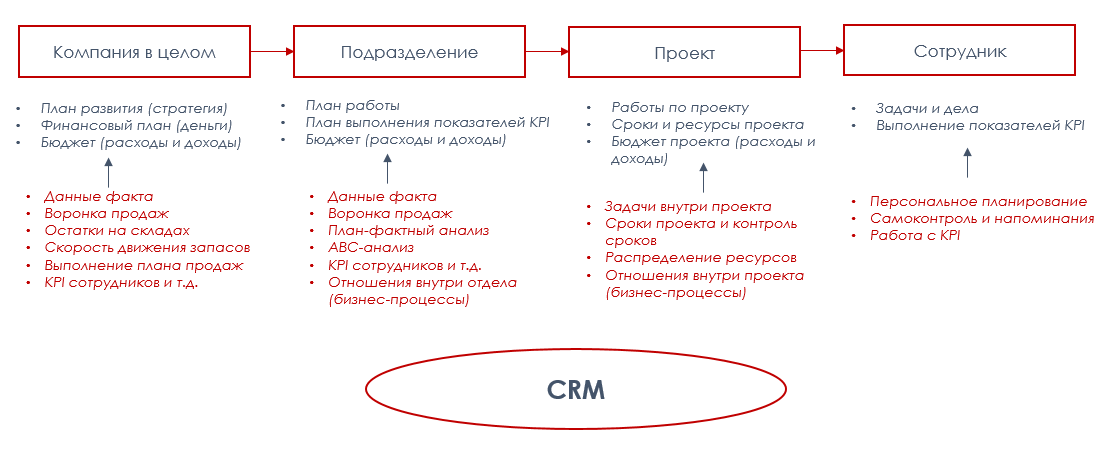
Clickable scheme
CRM-system at the level of the employee and the project allows you to conduct almost all processes and take into account the maximum data. When used in a division or company as a whole, it performs the function of a source of information for planning and forecasting along with ERP, accounting system, internal billing, etc. A set of automation tools depends on the scope of the company and management tasks. For example, a construction company can easily get by with a CRM + 1C bundle, and a telecom operator or Internet provider needs a billing system.
Let us dwell on each of the types of planning on the principle from the particular to the general, that is, from the employee to the company as a whole.
Parkinson's law says: the work takes all the time allotted to it. Perhaps, it has stories about everything: about procrastination, and about workaholism, and about the insane traffic of social networks and entertainment sites during working hours. Of course, the employer's view is simple and honest: I give money in exchange for your time - you are working at this time. Some subordinates believe that given 7-8 hours is enough, and without work. Accordingly, the task of the manager is to ensure the performance of work, the task of the employee is to make the workflow simple and productive, primarily for himself. Planning is the way to solve problems of both parties.
Our team ( RegionSoft ) has always strived to develop , in addition to the core of the CRM system in the classical sense (contacts, transactions, reports), the entire accompanying set of functions, including making tools and modules within the program that employees will like and will provide them with convenience and speed of work. This is what happens in CRM (as always, using the example of RegionSoft CRM , although today many systems have some form of personal planning mechanism).
A three-week planner is responsible for planning each individual employee (the employee sees himself, the head of the department — his subordinates, the director — all). Convenient aggregated calendar for assessing the volume and degree of workload of managers. Just look at it to understand who can assign tasks, and who are already in business. Additionally, for the load levels, a color indication is entered.
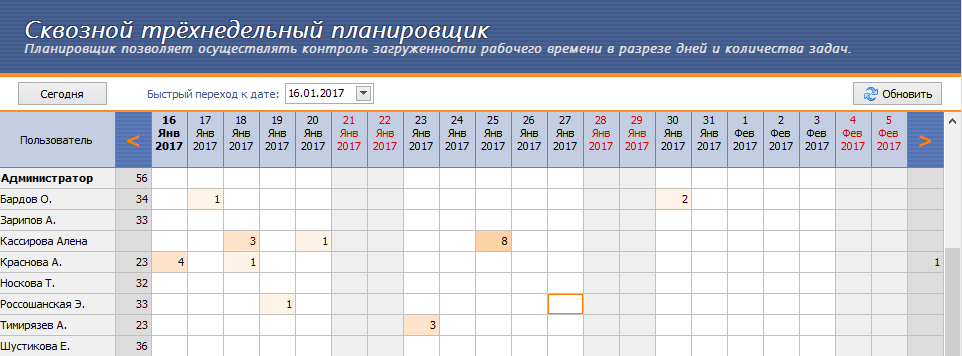
From the three-week scheduler, you can open the visual planner of the day: it contains information about all the tasks assigned to the employee by him or the manager. The calendar is simple and familiar - tasks are created right in it, dragged by the mouse. In square brackets, before the name of the task, the client to which it belongs is displayed.
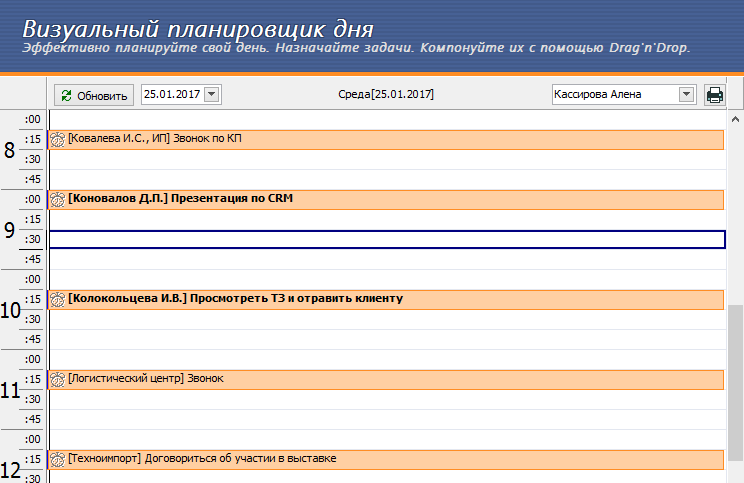
The task manager and the employee themselves are available in a visually convenient registry, which displays the status of the task, the importance, the task itself, the deadlines. You can easily track outstanding tasks for each employee and director, assess the stage of the task. By the way, such groupings in CRM systems or project management systems save time to assess the situation, allow you to quickly prepare for meetings and make the workflow transparent.

Personal planning is an important tool for productivity growth, but it’s not enough for a business to fulfill its goals. Therefore, another planning tool is KPI - key performance indicators. They set goals (planned values), which are then measured in proportion to the employee’s achievements (actual values). We already told on Habré how and why we worked through the KPI mechanism in RegionSoft CRM . Most of all, employees like the fact that they always keep a KPI monitor in front of their eyes, where progress is visible for each indicator. It helps to restructure and plan their work within a month.
The task of the employee: to perform the work correctly, on time and in accordance with the established scope (plan). Accordingly, for him, automation consists in ensuring comfortable work. No matter how uniquely the duties of a modern person may look, at work he faces an endless avalanche of minor matters, because of which more important things are often forgotten, minor tasks are abandoned. Another negative situation is the unstructured flow of tasks from the manager, who, as you know, needs everything at once and preferably yesterday. Under conditions of such tension, key indicators are not fulfilled, deadlines for the implementation of projects are disrupted, and, ultimately, intra-company problems affect clients whose dissatisfaction reduces revenue. And this vicious circle can be broken in two ways:
A project or division can be considered in the aggregate, since without the context of the company itself, they represent the same structure: a set of users who perform one big task, divided into subtasks (personal planning). Here's what to look for in planning at the project or department level:
It is better if there is some general task control mechanism: it can be a special program, an A4 sheet, a marker or a scrum board. Regardless of the management methodology used by the team, it must be able to receive current information on the degree of performance of each employee’s work and on the project as a whole.
In part, we were inspired by such boards, in part - by the Gantt chart, but we tried to find a simplified and visual approach that would be understandable to all users: from secretary and telemarketer to developer and production worker. Another type of schedulers that we use in RegionSoft CRM is a thematic group task scheduler. This is a mechanism that is essentially similar to the Gantt chart, but more convenient specifically for commercial services. In one table displays the stages of work, status, progress, deadlines responsible. Thus, it is possible to plan the loading of each employee at a specific stage.

The most difficult part of planning is in-house planning, which occurs at the company level. This topic includes dozens of approaches and techniques, but we are interested in the possibility of automating planning.
In general, for some reason, it is believed that strategic and financial planning is the lot of large companies with branch offices, holding companies and corporations. In fact, everyone is planning: a tiny design agency “for three”, a fuel company, a government, and transnational corporations. Moreover, the essence of planning is the same: provide for expenses, predict incomes, describe methods and sources of expenses and incomes as part of the strategy. Only numbers and formalization levels are different.
In order for planning in the company to work as a plus, not as a minus and does not look spontaneous, you need to follow a few rules, and not only at the in-house, but at every level.
The plan must be realistic. You should not make your ambitions or diligently underestimate it to motivate employees. These must be doable tasks and indicators. To ensure realism, you should refer to the historical data on the company or other projects and create a plan on their basis. In the future, on the basis of the plan-factual analysis, an adjustment must be made and, thus, to achieve maximum feasibility. Just when forecasting and planning indicators, automation starts to play the role again - if all the data is collected and stored in CRM, it is easy to get information both in retrospect and for plan-fact analysis.
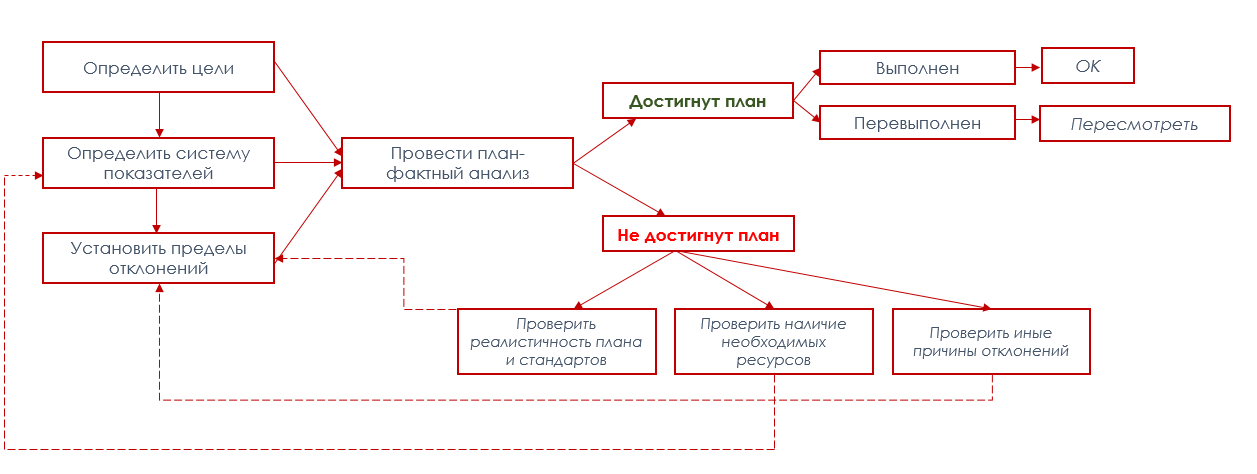
Clickable scheme
The plan must be continuous - plan better in equal periods: month, quarter, year, etc. Thus, you will receive not only the achievement of indicators, but also a competent analytical base for further strategies.
The plan must be flexible. No matter how accurate the forecast, plan adjustments are inevitable. If adjustments lead to additional difficulties or costs, then planning is based on incorrect data or the wrong strategy is chosen. In addition, the company is in the external environment, and you need to be prepared for changes from the outside - for example, changes in legislation, customer or supplier care, etc.
The plan must be collaborative and transparent. In general, there are three basic planning methods.
Let's go back to compatibility. If you are not a defense plant, then employees must be allowed to discuss and draw up a plan, because it is behind them that there is a tactic that implements the strategy and sometimes they see factors that go out of sight of the manager. But at the same time, the unfounded “we will die, but we will not do it” and “well, here it usually goes badly” should not be accepted - only an analytical substantiation of all the numbers and terms.
In planning, tactics and strategy must match each other. Often, the company faces global goals: develop a new version of software or a new product, capture market share, grow by N% from the previous period, etc. This is a strategy. Tactics are concrete actions that should be aimed at achieving each of these goals.
Prioritization is an important point in planning all levels. There are always tasks of varying degrees of importance: both the leader and the subordinates must be able to prioritize and count resources based on the complexity and importance of the stage or indicator. By the way, in RegionSoft CRM you can not only prioritize clients and tasks, but also put down the weight of KPI coefficients - thus, an employee will receive a signal that he is now in the first place, and will not do what he has faster and better it turns out.
Automation - an assistant when planning. We have already shown examples of automating personal planning, told us which indicators can be pulled out of CRM for a plan. In fact, planning serves almost all corporate sector programs: monitoring and IT audit systems help plan the costs of software and hardware (ITAM — IT asset management), the CRM system — plan sales, procurement, work with projects, and bugtracker — plan the work of developers and testers, ERP-system - production, etc.
By the way, the planning attributes are best described by the concept of SMART tasks. The plan should be SMART:
S - specific (specific) - the plan formulates the tasks and specifies the goals.
M - measurable (measurable) - there should be a system for assessing the implementation of the plan (indicators, system state points, stages of work).
A - achievable (attainable) - the company must make a plan, based on the resources and willingness to incur financial costs.
R— relevant (relevant) - the plan should be aimed at achieving a strategy, regulate each stage of progress towards the goal.
T - correlated with a specific term (time-bounded) - the plan should have a period with a start and end date, within which the fact will be assessed further.
This is how an approximate scheme of work with a sales plan in a company looks like (almost everybody needs to be sold, but sometimes sales are built without a plan or a plan is taken from the ceiling).
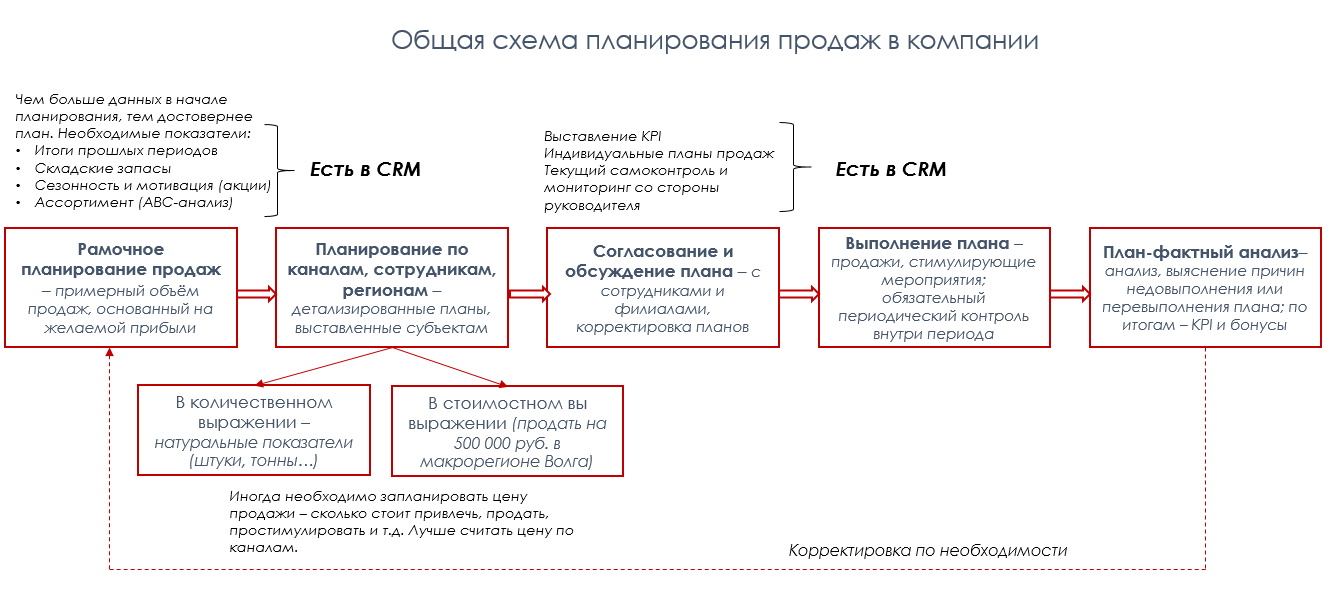
Clickable scheme
Each company has its own planning dates, which are determined by the product, features of the sales model, etc. But, as a rule, they roughly fit into the generally accepted periods of time.
You need to look into the external environment - it has an increasing impact on the business, but this does not mean that the business must obey the lines of motion and reduce the plans for the first drop in the cost of a barrel of oil. Consider the main factors of influence on the example of various markets.
The processes in the company should not be spontaneous.
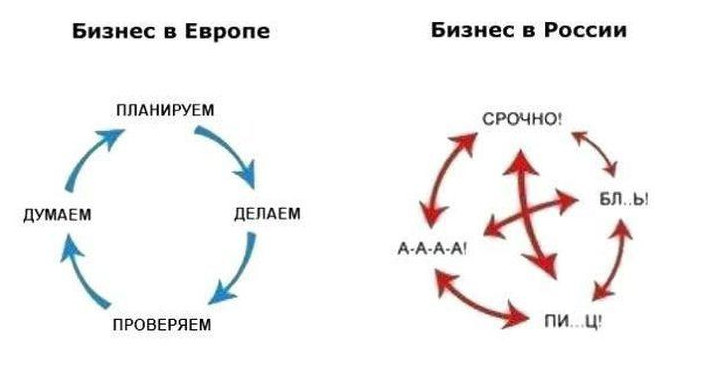
In the conditions of a total lack of planning, the business will not be able to grow; employees will not be able to fulfill their duties. The maximum that will come of this is a series of meetings and recriminations in the failure of the project. Even just operational planning provides important benefits:
Somehow on one defense of the thesis, where I had to attend, an interesting phrase from the study sounded: 10 minutes of morning planning save 2 hours of working time. It was definitely not just a thesis - in fact, planning, both the company and the employee gain time - the very thing in which you can study, engage in strategic developments, discuss the future of the company or, at worst, simply do not process it until the deep evening. Planning is the way of the company and each individual employee in it. Agree, go, when you know where you are going, much better.

Planning to one degree or another has always existed. But if prior to the beginning of the 20th century, it related more to an individual plan of affairs or, conversely, plans across the country, then it has firmly entered the company since the 1930s. In the capitalist West, intrafirm planning almost immediately began to be used to control the scale and resources with the aim of earning more profit; in a young USSR, the plan became a goal pushing people to labor exploits, fulfillment and overfulfilment. Perhaps, it is difficult to find someone who has not heard the slogan "Five-Year Plan - in four years" or did not see the Soviet posters on the implementation (and more often - over-fulfillment of the plan).
The plan was transformed along with the management paradigm:
')
1930 - 1940 - The era of formation of mass production. There are no plans as such, but the first prototypes appear.
1940 - 1950 - the period of industrial development due to the requirements of the wartime economy, the beginning of the arms race. Plans appear, volumetric scheduling is born, concepts of logistics, finance, budgeting arise.
1950 - 1980 - in the USSR, a command-planned economy, five-year plans, Stakhanov over-fulfillment of the plan, rationing. Abroad from the long-term planning inherent in the industrial economy, are moving to short-term, medium-term, strategic planning appears.
By the way, here are the Soviet posters about the plan and overfulfilment













1980 - to present - strategic planning is gaining strength, planning itself is assimilated with budgeting, finance and marketing. The USSR is in decay, Russia comes to a free market, and then actively adopts the accumulated experience of strategic management, whimsically combining it with elements of a planning-command system. Until now, there are planning departments and budget planning services in Russian companies. And the word “budget” often hides the most usual plan for 1-2 years.
Today everyone is planning, regardless of the scale of the business and whether they consciously do it.
Moreover, contrary to the canonical classification of planning by content, purpose, subject, period, classification by planning level comes to the first place: organization - division - executable project - employee.

Clickable scheme
And this is another area of activity of the company, which inevitably faces automation or uses its services. Here is how it happens in the case of a CRM system:

Clickable scheme
CRM-system at the level of the employee and the project allows you to conduct almost all processes and take into account the maximum data. When used in a division or company as a whole, it performs the function of a source of information for planning and forecasting along with ERP, accounting system, internal billing, etc. A set of automation tools depends on the scope of the company and management tasks. For example, a construction company can easily get by with a CRM + 1C bundle, and a telecom operator or Internet provider needs a billing system.
Let us dwell on each of the types of planning on the principle from the particular to the general, that is, from the employee to the company as a whole.
Employee - life in the CRM-system
Parkinson's law says: the work takes all the time allotted to it. Perhaps, it has stories about everything: about procrastination, and about workaholism, and about the insane traffic of social networks and entertainment sites during working hours. Of course, the employer's view is simple and honest: I give money in exchange for your time - you are working at this time. Some subordinates believe that given 7-8 hours is enough, and without work. Accordingly, the task of the manager is to ensure the performance of work, the task of the employee is to make the workflow simple and productive, primarily for himself. Planning is the way to solve problems of both parties.
- Plan your time - not only for the day, but also for the week and the month. Few are engaged in activities with a high degree of unpredictability. A CRM system installed on an employee on a PC should first of all become a business calendar with a bonus: reminders and alerts, so as not to forget a single case and complete tasks on time.
- Plan on time - it is best to build a work plan at the beginning of the period when you have not yet begun to perform tasks. There is a nice bonus in this rule: perhaps something can be delegated to other employees, and you can concentrate on a larger, but important task.
- Prioritize importance and urgency. Of course, at work there will always be tasks with a deadline of “just yesterday” and the wording “yes here on trifles”, but in general, the main tasks should be given priority (by the way, is also done in the CRM system and generally any task manager).
- Group homogeneous tasks - this will allow you to focus on the implementation of the task chain and close most of the project.
- Save time on routine work. For example, on the search for contacts or documents. If you have a CRM system, then find the right contact and document in it — a matter of seconds, if not — find a suitable application for contacts, carefully distribute documents into folders and sections (no, well, someone continues to live like this!) .
- Be lazy - always try to simplify the way to complete the task. So even within the toughest plan you will be able to gain time for a more difficult task or for a short break.
- Regulate the time (this is more true for managers) - for calls, meetings, presentations, trips to the client. Obviously, situations are different, but knowing the standard, an employee is less likely to break it.
Our team ( RegionSoft ) has always strived to develop , in addition to the core of the CRM system in the classical sense (contacts, transactions, reports), the entire accompanying set of functions, including making tools and modules within the program that employees will like and will provide them with convenience and speed of work. This is what happens in CRM (as always, using the example of RegionSoft CRM , although today many systems have some form of personal planning mechanism).
A three-week planner is responsible for planning each individual employee (the employee sees himself, the head of the department — his subordinates, the director — all). Convenient aggregated calendar for assessing the volume and degree of workload of managers. Just look at it to understand who can assign tasks, and who are already in business. Additionally, for the load levels, a color indication is entered.

From the three-week scheduler, you can open the visual planner of the day: it contains information about all the tasks assigned to the employee by him or the manager. The calendar is simple and familiar - tasks are created right in it, dragged by the mouse. In square brackets, before the name of the task, the client to which it belongs is displayed.

The task manager and the employee themselves are available in a visually convenient registry, which displays the status of the task, the importance, the task itself, the deadlines. You can easily track outstanding tasks for each employee and director, assess the stage of the task. By the way, such groupings in CRM systems or project management systems save time to assess the situation, allow you to quickly prepare for meetings and make the workflow transparent.

Personal planning is an important tool for productivity growth, but it’s not enough for a business to fulfill its goals. Therefore, another planning tool is KPI - key performance indicators. They set goals (planned values), which are then measured in proportion to the employee’s achievements (actual values). We already told on Habré how and why we worked through the KPI mechanism in RegionSoft CRM . Most of all, employees like the fact that they always keep a KPI monitor in front of their eyes, where progress is visible for each indicator. It helps to restructure and plan their work within a month.
The task of the employee: to perform the work correctly, on time and in accordance with the established scope (plan). Accordingly, for him, automation consists in ensuring comfortable work. No matter how uniquely the duties of a modern person may look, at work he faces an endless avalanche of minor matters, because of which more important things are often forgotten, minor tasks are abandoned. Another negative situation is the unstructured flow of tasks from the manager, who, as you know, needs everything at once and preferably yesterday. Under conditions of such tension, key indicators are not fulfilled, deadlines for the implementation of projects are disrupted, and, ultimately, intra-company problems affect clients whose dissatisfaction reduces revenue. And this vicious circle can be broken in two ways:
- strictly regulate relations, perform a strictly defined range of tasks, enter into conflict and demand the formalization of each request, thereby completely destroying the working atmosphere and human relations;
- use a CRM system that helps the manager to see, monitor and regulate the workload of subordinates, and the subordinates monitor the progress and successfully plan their work affairs.
Planning in the project and division - focus on each employee
A project or division can be considered in the aggregate, since without the context of the company itself, they represent the same structure: a set of users who perform one big task, divided into subtasks (personal planning). Here's what to look for in planning at the project or department level:
- control the load of each employee, evenly distribute tasks (not forgetting to take into account the qualifications, experience and skills of each);
- track links and intersections of works (for example, until there is text for the site, the designer will not be able to fully develop the page design - he needs to proceed from the volume, location and logic of the elements);
- control resources: working and non-working time, costs;
- track your key performance indicators (for example, budget, sales plan, number of fixed bugs, test plan, etc.);
- coordinating work is the task of the team leader, the head of the department, etc.
It is better if there is some general task control mechanism: it can be a special program, an A4 sheet, a marker or a scrum board. Regardless of the management methodology used by the team, it must be able to receive current information on the degree of performance of each employee’s work and on the project as a whole.
In part, we were inspired by such boards, in part - by the Gantt chart, but we tried to find a simplified and visual approach that would be understandable to all users: from secretary and telemarketer to developer and production worker. Another type of schedulers that we use in RegionSoft CRM is a thematic group task scheduler. This is a mechanism that is essentially similar to the Gantt chart, but more convenient specifically for commercial services. In one table displays the stages of work, status, progress, deadlines responsible. Thus, it is possible to plan the loading of each employee at a specific stage.
Here it is worth making a small lyrical digression. Initially, the Gantt chart was conceived as a tool for planning work in production, where she found a successful application. It is used to plan resources, load production equipment, etc. Later, it got accustomed to project management and migrated to RM software solutions, which (not everyone, really) cut it off, simplified it and made it just a timeline without the initial idea of resource management and process control. Therefore, if you cut the Gantt chart in the corporate software, then it is for the production management section. Moreover, now along with Gantt, PERT and GERT diagrams are used (again, network planning), they are even more interesting for software implementation. And if someone really needs them not for a beautiful screen at the meeting, but for work and production planning, we will consider the possibility of such refinement for a specific client.

Planning in the company - data strategy
The most difficult part of planning is in-house planning, which occurs at the company level. This topic includes dozens of approaches and techniques, but we are interested in the possibility of automating planning.
In general, for some reason, it is believed that strategic and financial planning is the lot of large companies with branch offices, holding companies and corporations. In fact, everyone is planning: a tiny design agency “for three”, a fuel company, a government, and transnational corporations. Moreover, the essence of planning is the same: provide for expenses, predict incomes, describe methods and sources of expenses and incomes as part of the strategy. Only numbers and formalization levels are different.
What should be the plan?
In order for planning in the company to work as a plus, not as a minus and does not look spontaneous, you need to follow a few rules, and not only at the in-house, but at every level.
The plan must be realistic. You should not make your ambitions or diligently underestimate it to motivate employees. These must be doable tasks and indicators. To ensure realism, you should refer to the historical data on the company or other projects and create a plan on their basis. In the future, on the basis of the plan-factual analysis, an adjustment must be made and, thus, to achieve maximum feasibility. Just when forecasting and planning indicators, automation starts to play the role again - if all the data is collected and stored in CRM, it is easy to get information both in retrospect and for plan-fact analysis.

Clickable scheme
The plan must be continuous - plan better in equal periods: month, quarter, year, etc. Thus, you will receive not only the achievement of indicators, but also a competent analytical base for further strategies.
The plan must be flexible. No matter how accurate the forecast, plan adjustments are inevitable. If adjustments lead to additional difficulties or costs, then planning is based on incorrect data or the wrong strategy is chosen. In addition, the company is in the external environment, and you need to be prepared for changes from the outside - for example, changes in legislation, customer or supplier care, etc.
The plan must be collaborative and transparent. In general, there are three basic planning methods.
- Retrograde (reactive) method - the plan descends from above and is not subject to adjustments and discussion. It can be done or not done, but not changed, even for objective reasons. Such plans work mainly in defense enterprises and enterprises with state orders, but nothing prevents them from doing so to heads of small and medium-sized businesses. But, unlike the plant, such a manager may face loss of personnel or permanent failure to fulfill the plan due to its inertia and isolation from the real possibilities.
- Progressive method - a plan is prepared first for each manager, then it is coordinated and adjusted in the department and then proposed for management approval. This is a good method that works in retail, from providers, in affiliated companies, but it is fraught with under-planning and KPI - therefore, the manager must own the entire set of real information. Again, a CRM system comes to the rescue, in which he can view not only plans and facts, but also a sales funnel for each manager, carry out ABC analysis, and also see overdue and completed tasks ahead of schedule.
- Counter-planning - the overall strategic plan descends from above, a detailed plan for implementing the strategy rises from below. For example, a manager wants to sell 1,000 motorboats in a year, while marketers and salespeople analyze the results of previous periods and, taking seasonality into account, break it: 10 in January, 10 in February, 300 in April, 300 in May, etc. Perhaps this is the best method, taking into account the interests of all parties.
Let's go back to compatibility. If you are not a defense plant, then employees must be allowed to discuss and draw up a plan, because it is behind them that there is a tactic that implements the strategy and sometimes they see factors that go out of sight of the manager. But at the same time, the unfounded “we will die, but we will not do it” and “well, here it usually goes badly” should not be accepted - only an analytical substantiation of all the numbers and terms.
In planning, tactics and strategy must match each other. Often, the company faces global goals: develop a new version of software or a new product, capture market share, grow by N% from the previous period, etc. This is a strategy. Tactics are concrete actions that should be aimed at achieving each of these goals.
Prioritization is an important point in planning all levels. There are always tasks of varying degrees of importance: both the leader and the subordinates must be able to prioritize and count resources based on the complexity and importance of the stage or indicator. By the way, in RegionSoft CRM you can not only prioritize clients and tasks, but also put down the weight of KPI coefficients - thus, an employee will receive a signal that he is now in the first place, and will not do what he has faster and better it turns out.
Automation - an assistant when planning. We have already shown examples of automating personal planning, told us which indicators can be pulled out of CRM for a plan. In fact, planning serves almost all corporate sector programs: monitoring and IT audit systems help plan the costs of software and hardware (ITAM — IT asset management), the CRM system — plan sales, procurement, work with projects, and bugtracker — plan the work of developers and testers, ERP-system - production, etc.
By the way, the planning attributes are best described by the concept of SMART tasks. The plan should be SMART:
S - specific (specific) - the plan formulates the tasks and specifies the goals.
M - measurable (measurable) - there should be a system for assessing the implementation of the plan (indicators, system state points, stages of work).
A - achievable (attainable) - the company must make a plan, based on the resources and willingness to incur financial costs.
R— relevant (relevant) - the plan should be aimed at achieving a strategy, regulate each stage of progress towards the goal.
T - correlated with a specific term (time-bounded) - the plan should have a period with a start and end date, within which the fact will be assessed further.
This is how an approximate scheme of work with a sales plan in a company looks like (almost everybody needs to be sold, but sometimes sales are built without a plan or a plan is taken from the ceiling).

Clickable scheme
And what about the timing?
Each company has its own planning dates, which are determined by the product, features of the sales model, etc. But, as a rule, they roughly fit into the generally accepted periods of time.
- Strategic planning - over 5 years. Defines the development prospects of the company. If we talk about the well-known HR-stamp, it answers the question “How do you see your company in 5 years?” The plan focuses on specific tasks in the long term: maintain market share, launch three new models, repurpose to a new type of activity, etc. . Such a plan determines where to invest, which competitors to surpass, for whom to work, how the market will move. Today, the external environment of business is so dynamic that such a plan in many areas becomes akin to fortune telling, but you still need to be able to capture trends. And, of course, a company whose full budget hole and money is enough only for operational work should not be engaged in strategic planning at all - it’s just an air lock and dreams of future billions. Financial and strategic planning are firmly linked to each other: the strategy knows what and why, and finances - how and when we can.
- Medium-term planning - 3-5 years. In large companies determines the ratio of the necessary resources for the production of the desired volume of products. As a rule, in small and medium business does not apply or is limited to 1-2 years.
- Short-term planning - up to 1 year. Compares the volume of production / sales with available resources, including labor. Often intersects with budgeting and financial planning.
- Operational planning - from 1 day to 1 quarter. The very plans for which the company operates daily.
What else have you considered where to look?
You need to look into the external environment - it has an increasing impact on the business, but this does not mean that the business must obey the lines of motion and reduce the plans for the first drop in the cost of a barrel of oil. Consider the main factors of influence on the example of various markets.
- Track trends - so you can redistribute investments to a new product, if you are interested in it, or gain a foothold in your segment. However, you should not blindly follow the fashion and change the technology / delivery model / sales system - this can lead to losses, bankruptcy, narrowing of the target audience, etc. For example, in the CRM market, a fashion for the clouds. However, the real serious solutions are offered only in the desktop / server, and more and more business executives are beginning to understand this. The clouds are mainly interesting for startups and small players, for whom safety and functionality are on the second and third plans. All major vendors managed to either upgrade their desktop products or create secure server versions.
- Watch out for competitors - how they fit into the market, what activities are carried out, how much their awareness is decreasing or increasing. We will not give an example in our market - this is not ethical. Cell operators are a good example. Tele2 has always been distinguished by its attention to the policies of its competitors, and sometimes held similar actions in the regions, but in the end was able to build up, find a niche, dial a subscriber base, and turned the big three into the big four.
- Profitability (the share of profits in each ruble earned revenue) is a sore subject of business. It would be desirable in excess of profitability, which they are trying to achieve by increasing prices, and not by optimizing processes. Recently, companies have found an external reason for the growth of profitability - some Russian software vendors have raised prices because of the dollar exchange rate, and very disproportionately. They lost in the number of customers and sank in places. , ( IDE — CRM), , .
- , , ( : , , — , ).
- Economic indicators will always affect the business that is part of this ecosystem. It is necessary to take into account the danger of artificial negative: for example, during a crisis, companies are holding onto funds and selling software is more difficult. And sometimes, on the contrary, they see automation as a cost-cutting tool (it is) and buy software. Such movements need to be considered and try to plan growth even in a falling market.
Well, everything is fine, but I have a small business, why should I plan?
The processes in the company should not be spontaneous.

In the conditions of a total lack of planning, the business will not be able to grow; employees will not be able to fulfill their duties. The maximum that will come of this is a series of meetings and recriminations in the failure of the project. Even just operational planning provides important benefits:
- — , ;
- — , , ;
- — , - ;
- — , , , , (, — ).
Somehow on one defense of the thesis, where I had to attend, an interesting phrase from the study sounded: 10 minutes of morning planning save 2 hours of working time. It was definitely not just a thesis - in fact, planning, both the company and the employee gain time - the very thing in which you can study, engage in strategic developments, discuss the future of the company or, at worst, simply do not process it until the deep evening. Planning is the way of the company and each individual employee in it. Agree, go, when you know where you are going, much better.
Source: https://habr.com/ru/post/319928/
All Articles